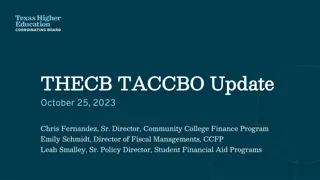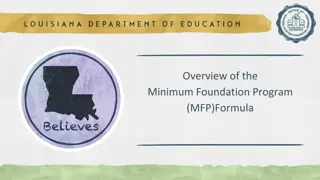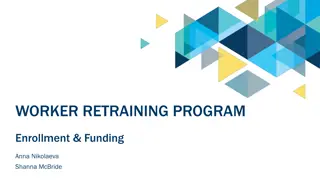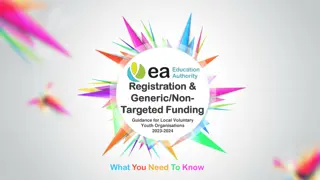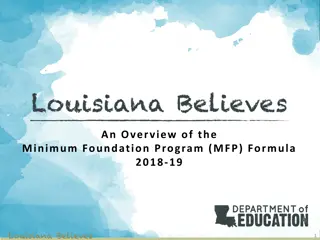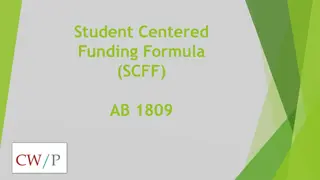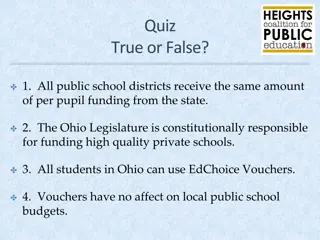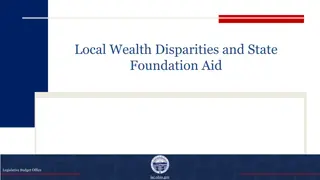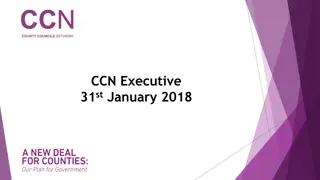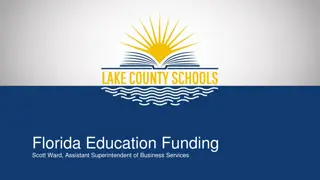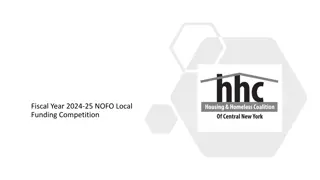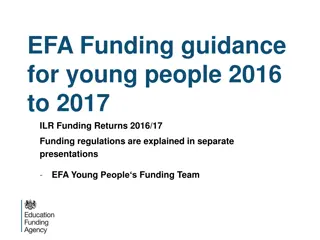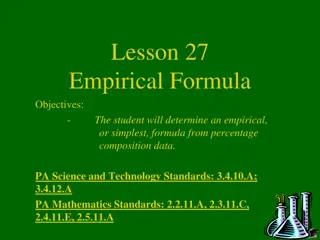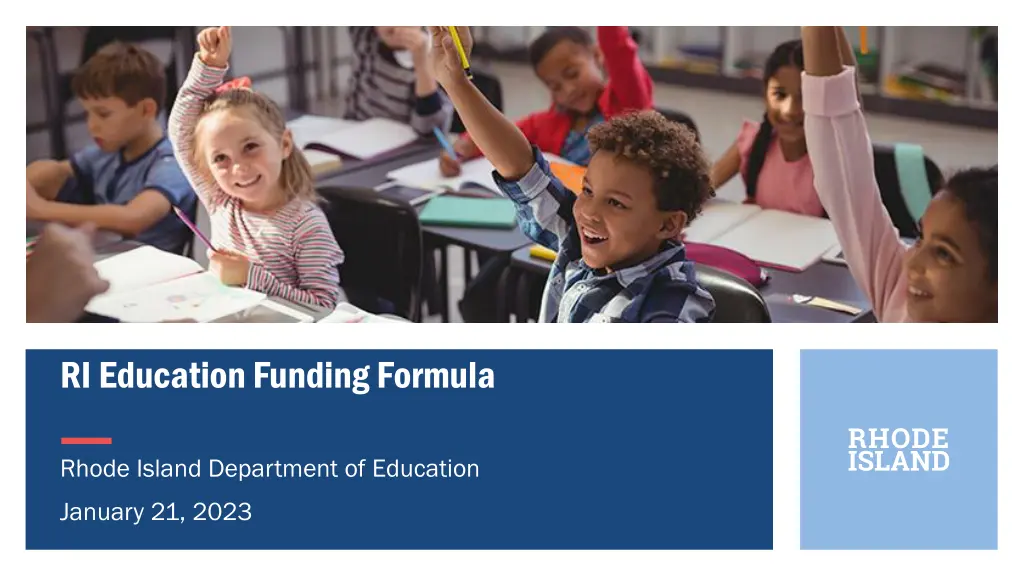
Rhode Island Education Funding Formula Trends and Impact Overview
Explore Rhode Island's education funding formula history, expenditures trends, funding goals, and revenue sources from 2011 to 2023. Discover insights on statewide expenditures, per pupil expenditures, historical revenues, and the impact of the funding formula on education funding distribution and budget shifts.
Download Presentation

Please find below an Image/Link to download the presentation.
The content on the website is provided AS IS for your information and personal use only. It may not be sold, licensed, or shared on other websites without obtaining consent from the author. If you encounter any issues during the download, it is possible that the publisher has removed the file from their server.
You are allowed to download the files provided on this website for personal or commercial use, subject to the condition that they are used lawfully. All files are the property of their respective owners.
The content on the website is provided AS IS for your information and personal use only. It may not be sold, licensed, or shared on other websites without obtaining consent from the author.
E N D
Presentation Transcript
RI Education Funding Formula Rhode Island Department of Education January 21, 2023
Statewide Expenditures LEAs in Rhode Island spent approximately $2.6 billion in 2020-21 - an increase of 24% since 2011. Approximately 92% of the 2020-21 expenditures were incurred by traditional school districts with the remaining 8% spent by public schools of choice. Public schools of choice in 2020-21 spent $207 million which is more than double the 2011-12 amount. Note: Excludes Tuition to other RI Districts to avoid double counting 2
Historic Expenditures Trends From 2011 through 2019 (the last full school year before the pandemic), the statewide per pupil expenditures (PPE) for all state, local, federal funds (excluding debt and capital projects) increased. PPE increased by about 2.5% per year, while statewide enrollment increased by 1.7% over the same timeframe 2021-22 saw a sharp decline in enrollments 2011-12 New funding formula implemented School building closures and remote learning flattened PPE in 2019-20 Between 2019-2020 and 2020-2021, the PPE expenditures increased by 9.1% due to COVID-19 Federal Assistance Funds and decreased enrollment COVID-19, School buildings closed in March 2020 Average Daily Membership (ADM) = Historical Expenditures per Pupil and Average Daily Membership (All LEAs) 3
Funding Formula Goals Transparency Predictability Fair and equitable distribution of state education aid funds Funds follow the student 4
History and Context Enacted FY 2010 RIGL 16-7.2-3 Fully funded since FY 2021 Increased state education funding by more than $350M. since initial enactment Increased approximately 50% to more than $1B in FY 2023 Has resulted in an unintended statewide shift in education funding from municipal budgets in high share ratio local education agencies. 5
Historic Revenues (2011-12 to 2020-21) Since the implementation of the funding formula state sources of revenue have increased, in some cases replacing revenue from local taxes Traditional LEAs in Rhode Island received approximately $2.6 billion in revenues in 2020-21 over $20,000 per pupil 32.5% difference State revenues have grown at a much higher rate than local tax revenues: Cumulative increase in state revenues was 45.2%, Local taxes revenue increased by 12.7% 32.5% difference Historical Revenues by Source (Traditional School Districts) 6
Historic Revenues (2011-12 to 2020-21) Revenues from State Sources increased from 30.4% of total revenues in 2011-12 to 35.5% of total revenues in 2020-21 a 5.1 percentage points increase Revenues from Local Sources decreased from 57.4% of total revenues in 2011-12 to 52.1% of total revenues in 2020-21 a 5.4 percentage points decrease 9-Year Revenue Composition Percentage Point Change 7
Funding Formula Components Key Components: Core Instruction Per Pupil: FY 2023 = $11,050 Average of four New England states (RI,MA,CT,NH) Student Success Factor (40% of Core): FY 2023 = $4,420 Determined by poverty status of students State Share Ratio: considers the revenue-generation capacity of communities and student needs Student Enrollment/Data 8
Historic Core Instruction per Pupil (FY2012-FY2023) and YOY Change Regional Average of CT, MA, NH, and RI National Center for Education Statistics Data Core Instruction Expenditures per pupil have increased by 33% since FY 2012 9
Core and Non Core Instructional Functions The list below displays the UCOA functions that are included and excluded from the Core Instruction Component of the Funding Formula 10
Status of Student Success Factor Free and Reduced-Price Lunch numbers have decreased nearly 10% in last five years due to universal free food service and difficulty collecting supplemental income verification forms RIDE is required to develop a new poverty data factor for the FY 2024 budget submission; alternative must not be reliant on the administration of school nutrition programs Currently under review use of the Dept of Human Services data that directly certifies students matched in households that qualify for SNAP/TANF programs. 11
EWAV EWAV (Equalized Weighted Assessed Valuation): A calculation of a district s revenue-generating capacity. It is a number between 0 and 1 based on each district s assessed real estate values and a median income value. Equalized Weighted Assessed Valuation (EWAV) a component of the state share ratio calculated by the R.I. Department of Revenue. EWAV is calculated in the following manner: The total assessed valuations of real and tangible property for each municipality, as of December 31 of the third preceding year, adjusted to bring the property valuation to market value. This value is adjusted by the ratio that compares the median family income of a city or town to the statewide median family income, as reported in the latest available federal census data. In summary, the EWAV calculation takes into consideration both the property values of a community and the income of its residents. 13
Student Data All student data is generated by the LEA and submitted to RIDE through the enrollment census for formula calculations There are three student data snapshots during the year: October 1st Preliminary Distribution March 15 March 15th th Final Distribution Final Distribution June 30th State Share Ratio Due to declining enrollments (4,300 students since pre-pandemic), the General Assembly held student data harmless in the FY 2022 and FY 2023 budgets LEAs can periodically review enrollment census data RADM (resident average daily membership) State Calculated Report in eRIDE 14
Formula Calculation Formula Calculation - - Example Example (2,000 PK-12 RADM x x $11,050) = $22,100,000 + + (800 PK-12 SSF x x ($11,050 x x 40%)) = $3,536,000 x x State Share = 45.0% = = $11,536,200 $11,536,200 (projected state funding) RADM = resident average daily membership SSF = student success factor 15
Categorical Aid High-Cost Special Education Amount above 5 times the core plus student success factor is paid to districts In FY 2023 reimbursement starts at $77,350 Career and Technical Education Off set some expenses of high-cost programs Start up costs for new or transformed programs Transportation Regional School Districts @ 50% of cost Private out of District 16 High-Cost
Categorical Aid Multilingual Learners 10% of LEA core instruction amount times state share ratio for certain EL students Early Childhood Competitive Funding for pre-k classrooms Regional Bonus Two year bonus for new regional districts 2% year one and 1% year two 17
How does Rhode Island Compare in Revenues per pupil? Per Pupil Revenues by Source (2019-20) Total Per Pupil Revenues rank 12th highest in USA and 5th highest in New England (only Maine was below) State Per Pupil Revenues rank 20th highest in USA and 4th highest in New England (Main and New Hampshire were below) Massachusetts per pupil revenues were around $1,500 higher than Rhode Island with most of the difference explained by higher local per-pupil revenues. Source: NCES, 2019-20 is the latest data available 18
Public School of Choice Formula implements money follows the student ; local share calculation is: Total Local Contribution/All Public School Students = Per Pupil Per Pupil x # of students = Local Share to Charter, Davies, or Met Local share is billed quarterly and updated based on actual enrollment on the first day of each quarter (August 15th, October 1st, January 1st, and April 1st) RIGL 16-7.2-5(b) Beginning in FY 2017, the per pupil rate is reduced by the greater of 7% of the per pupil or the per pupil value of the district s unique costs - RIGL 16-7.2-5(c) 19
Potential Formula Changes Student Success Factor Public School of Choice Transition Fund Offset some of the costs of sending education agencies Increases in Certain Categorical Aids Fully fund Excess Special Education and Multilingual Learner New aid component to support students experiencing homelessness Hold Harmless supplemental transition fund Offset a percent of losses due to enrollment loss 20
Key Links and Contact Information District aid and calculation schedules On RIDE school financing web page Funding formula user s guide https://www.ride.ri.gov/Funding Finance/Funding Sources/StateEducationAid.aspx Contact information: Kristen Cole @ kristen.cole@ride.ri.gov Mark Dunham @ mark.dunham@ride.ri.gov 21

